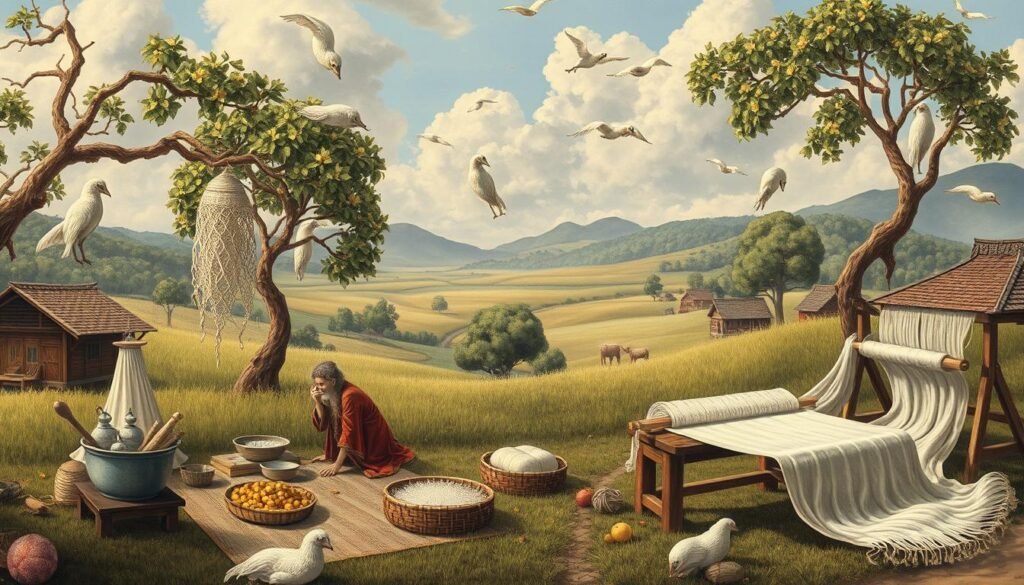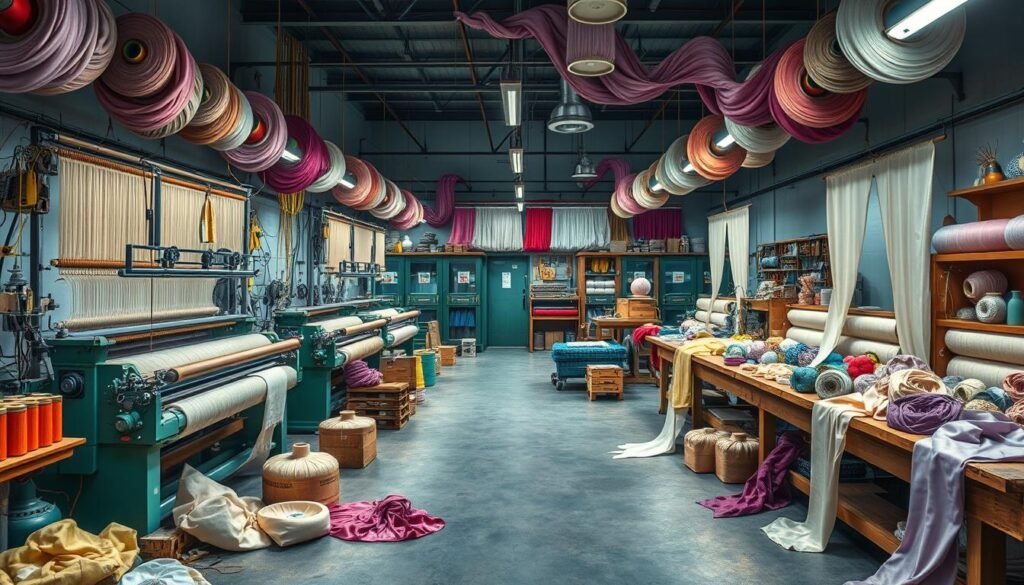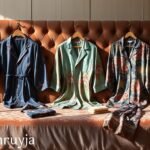Ever wondered about the making of the luxurious silk fabric? Silk is a natural textile that has amazed people for centuries. It’s known for its soft, shiny texture and top-notch quality1. Let’s dive into the history, making, and many uses of this amazing fiber.
Silk comes from the cocoons of certain insects, like the mulberry silkworm Bombyx mori1. This fabric has a rich history, starting in ancient China. Back then, it was a secret of the nobles2. Now, silk is loved worldwide for its special qualities and many uses in fashion, home decor, and industry.
Key Takeaways
- Silk is the strongest natural textile in the world, known for its soft, shimmering texture and luxurious feel.
- Silk is a natural protein fiber derived from the cocoons of certain insect larvae, primarily the mulberry silkworm Bombyx mori.
- Silk has a long and storied history, with its origins dating back to ancient China where it was once a closely guarded secret of the Chinese nobility.
- Silk is prized around the world for its unique properties and diverse applications in fashion, home furnishings, and industry.
- Mulberry silk is considered the highest quality silk fabric, known for its durability, moisture-wicking properties, and temperature regulation.
Introduction to Silk Fabric
Definition and Properties of Silk
Silk comes from a natural protein fiber called fibroin. It’s made by certain insects to build their cocoons3. This fiber is known for being very strong, soft, and shiny.
The way silk fibers are shaped lets them bend light, making them look shiny. Silk is the strongest natural fabric, known for its strength and lasting power3.
Historical Significance of Silk
Silk has a long history, starting in ancient China over 6,000 years ago4. Only the Chinese nobles could make silk, keeping its secrets safe. As China grew, silk went to other parts of the world.
This led to the Silk Road, a trade route from China to Europe and the Middle East4. Silk became very valuable and changed many cultures and economies.
“Silk was once the exclusive domain of the Chinese nobility, with the secrets of sericulture closely guarded.”
The story of silk starts in ancient China, thanks to Empress Hsi-Ling-Shi5. She introduced sericulture, which led to silk weaving. Silk became a sign of wealth and class, playing a big part in global trade and culture4.
Origins and Production of Silk
Silk started in ancient China, where the silk industry began before the 3rd millennium’s middle6. Legend says Empress Hsi-Ling-Shih found silk, starting a big industry that changed global trade for centuries. Silk is over four thousand years old, from ancient China7.
Silk Production in China
China became the top silk producer, making silk a big deal and a main export in the Han dynasty6. The mulberry silkworm, eating only mulberry leaves, is silk’s main source. China’s long silk history made it the world’s top silk supplier for centuries.
The Silk Road and Global Trade
China made silk and started the Silk Road in 130 BC to trade with the Middle East and Europe7. This trade network linked China to the world, letting Chinese merchants trade silk for goods from far away. Silk became a luxury item, with its secrets kept by the Chinese. Silk making spread to Asia, like Korea, India, and the Middle East6, but China led the silk trade for over a thousand years.
| Key Silk Production and Trade Milestones | Year |
|---|---|
| Silk discovered in China | 2696 BC7 |
| Silk Road established | 130 BC7 |
| Silk production reaches Korea | 200 BC7 |
| Silk production reaches Persia (Iran) | 6th century7 |
| Silk production reaches Japan | 4th century AD7 |
| Silk production reaches India | 400-600 AD7 |
| Silk Road closes | 1453 AD7 |
“The Silk Road remained operational for more than 15 centuries until 1453 A.D.”7
The Silk Road and silk production in China changed global trade. Silk became a luxury item worldwide. China’s lead in silk kept it a top supplier for centuries, but silk making spread to other areas.
How Is Silk Fabric Made?
Silk production, or sericulture, starts with raising silkworms. These are the larvae of the Bombyx mori moth. They eat only mulberry leaves. This makes them spin cocoons filled with silk filament8.
After the silkworms finish their cocoons, the silk is harvested. This means boiling the cocoons to get rid of the sericin. This glue-like stuff holds the silk fibers together8. Then, the silk fibers are unwound and joined to make a strong, shiny silk thread. This thread is then woven into silk fabric8.
The Sericulture Process
The sericulture process starts with silkworms growing for about 6 weeks to 3 inches long8. They spin their cocoons by moving their bodies 300,000 times in 3 to 8 days8. It takes around 2,500 silkworms to make just one pound of raw silk8.
Silk Yarn and Weaving
After getting the silk fibers from the cocoons, they are twisted into silk yarn. This yarn might be dyed or stiffened before being woven into fabric9. The weaving process uses the silk threads to create the fabric’s structure and design. This makes silk soft, smooth, and shiny9.
Old ways of dyeing silk used natural stuff like fruit or indigo leaves8. Now, there are more options like acid and reactive dyes for different colors8. Also, piece-dyeing cuts down on waste and keeps a stock of plain white silk for dyeing8.

“Silk is surprisingly strong and durable, with a tensile strength that allows it to withstand tension and pressure without tearing easily.”10
| Silk Fabric Type | Characteristics |
|---|---|
| Mulberry Silk | Exceptional quality, softness, and natural sheen10 |
| Tussar Silk | Unique texture and slightly rougher feel, natural and rustic appeal10 |
| Charmeuse Silk | Lightweight fabric with a glossy front and matte back, sensual allure and elegant drape10 |
Types of Silk Fabric
Mulberry silk, made by the Bombyx mori silkworm, is the most common type. But there are others with special features11.
Eri silk is a “peace silk” that doesn’t harm the silkworms11. Tasar silk, from Indian silkworms, shines naturally and lasts long11. Muga silk, from Assam, has a golden glow that catches the eye11. Spider silk is rare and strong, and sea silk comes from a Mediterranean mussel, making it very rare11.
| Silk Fabric | Key Characteristics |
|---|---|
| Charmeuse | Smooth and supple texture, ideal for luxurious nightwear, lingerie, and elegant evening gowns11. |
| Dupioni | Often used for bridal gowns, tailored suits, evening jackets, draperies, and decorative throw pillows, adding a touch of elegance11. |
| Chiffon | Prized for its lightness, offering a weightless and romantic feel when worn, often used in bridal gowns, blouses, scarves, and curtains11. |
| Habotai | Commonly used for blouses, skirts, lightweight jackets, linings, draperies, pillowcases, and delicate craft projects due to its versatility11. |
| Organza | Often used in formal wear, bridal gowns, decorative accents, ribbons, flowers, veils, and table runners for its stiff nature and ethereal appearance11. |
Each silk fabric has its own special qualities like sheen, weight, and how it hangs. This makes them great for fashion and home decor11. Most silk fabrics are made from mulberry silkworms12.
Silk fabrics can be woven or knitted12. Dupioni and shantung silks are light and slightly shiny12. Satin silks are soft and perfect for fancy looks12.
Creppe fabrics drape well and are light, perfect for many styles12. Crepe georgette is also great for summer clothes and blouses12.
What Is a Silk Fabric? A Complete Overview
Silk is a luxurious, natural textile with a long history. It started in ancient China13. It comes from the cocoons of the Bombyx mori silkworm. Silk is known for its softness, strength, and shiny look14.
The making of silk, called sericulture, is complex. It includes raising silkworms, collecting their cocoons, and turning the silk into fabric.
There are many types of silk, each with special features14. Eri silk is from the ailanthus silk moth and is very high quality14. Tussar silk is from moths in the Antheraea genus and is stiff14. Muga silk is the most expensive wild silk and was once only for royalty14.
Spun silk is made from silk waste and gives a rougher look14. Dupioni silk has a unique look with tiny slubs. It’s loved for its colors and look14.
Silk has always been a favorite in fashion and home decor13. Its quality is measured in Momme, with higher numbers meaning better quality13. Silk comes in many thicknesses, from 5mm to 40mm, each with its own uses13.
| Silk Fabric Type | Thickness Range (Momme) |
|---|---|
| Crepe de Chine | 12mm – 40mm |
| Georgette | 8mm – 23mm |
| Habotai | 8mm – 14mm |
| Organza | 5mm – 16mm |
| Chiffon | 5mm – 12mm |
| Cotton Silk | 9mm – 16mm |
| Twill Silk | 12mm – 19mm |
Silk is not only beautiful but also soft, chemical-free, and comfy for sleeping13. But, testing if silk is real can damage it13.
Uses of Silk Fabric
Apparel and Fashion
Silk is a top choice in the silk apparel and silk fashion world. It’s known for being soft, smooth, and luxurious. You can find silk clothing in many items like shirts, dresses, and silk accessories such as scarves15. It’s also great for undergarments because it’s light and lets air through15.
Silk’s special shine and light play make it perfect for fancy fashion items15.
Industrial and Medical Applications
Silk isn’t just for clothes; it has many silk industrial uses and silk medical uses. It’s strong yet light, making it great for parachutes16. Silk is also used in silk surgical sutures because it fights bacteria and helps healing16.
Its many uses extend to making bike tires and parts for technical and medical devices16.

“Silk is a strong natural fiber with good tensile strength, and it can be stretched from 10% to 20% of its original length without breaking, indicating its elasticity.”16
Major Silk Producing Countries
China leads the world in silk production, making about 80% of the world’s silk17. This country has been a top producer for thousands of years17. Its large mulberry farms and sericulture help it stay at the top17.
India is also a big player, making about 28,000 metric tons of silk each year18. Uzbekistan and Thailand add 6,500 and 1,000 metric tons, respectively18. Together with China, they are the main suppliers of silk to the world18.
China’s Dominance
China is unmatched in the silk industry. It makes about six times more silk than India17. The world produces around 202,000 metric tonnes of silk yearly, with China making most of it17. Silk costs about US$15 per kilo, making its yearly value around $3.03 billion17.
Other Major Producers
China isn’t the only big name in silk. India, Uzbekistan, Thailand, Brazil, and Vietnam are also key players18. They add thousands of metric tons of silk to the market every year18.
The International Sericultural Commission helps promote silk worldwide17. There are also three main types of sustainable silk available17.
| Country | Annual Silk Production (Metric Tons) |
|---|---|
| China | 146,000 |
| India | 28,708 |
| Uzbekistan | 6,500 |
| Thailand | 1,000 |
| Brazil | 560 |
| Vietnam | 420 |
| North Korea | 320 |
| Turkey | 32 |
China is the top silk producer, but other countries are also important in the industry. The trade of silk and silk products is growing, thanks to its popularity1718.
Cost and Availability of Silk
Silk is seen as a luxury item because making it is hard work and it’s not easy to get19. It’s a tiny part of the world’s fabric market but is a big deal in the industry19. In China, raw silk costs between $50 and $55 per kilogram19.
This high price comes from the hard work needed to make silk. This includes growing mulberry trees, raising silkworms, and processing the silk19.
Even though silk is made in more places, it’s still rare. This makes it very wanted and a top choice for natural fabrics19. Making silk is mostly done in places where workers are paid less19. In China, silk supports 1 million workers, in India, 700,000 households, and in Thailand, 20,000 weaving families19.
There are greener silk choices too. These include organic silk and peace silk, where moths can come out of their cocoons19. These options are better for the planet and are a good choice for those who want silk but care about the environment19.
“Silk is a fine, strong, soft, lustrous fiber produced by silkworms, particularly mulberry silkworms, in making cocoons and collected to make thread and fabric.”20
Even with its high price and limited supply, silk is still very popular. Custom silk pajamas from Tianruiyi are a great choice for those who want luxury and sustainability.
Conclusion
Silk has a long history, starting in ancient China21. It comes from the cocoons of the Bombyx mori silkworm. Silk is known for being soft, strong, and shiny because of its special structure22. Making silk, or sericulture, is a detailed process that has gotten better over time21.
China is the top silk maker, but other countries like India, Uzbekistan, and Thailand also make silk21. Silk is used in fashion, home decor, and industry. It’s a valuable and sought-after natural product2123.
The silk industry is changing to be more green and kind22. New ways of making silk, like Ahimsa silk and Eri silk, are being found21. These changes help make silk production better for the planet and animals.
Silk is a special fabric that has amazed people for thousands of years21. It started in ancient China and has spread around the world. Now, it’s changing to meet today’s needs and concerns. Silk’s future looks bright, with more innovation and care for this valuable resource.
FAQ
What is the definition and properties of silk?
Silk comes from the cocoons of certain insects, like the mulberry silkworm. It’s known for being strong, soft, and shiny. This is because of its special structure that bends light.
What is the historical significance of silk?
Silk has a rich history, starting in ancient China. It was a secret of the nobles. This led to the Silk Road, a network of trade routes that reached far and wide.
How is silk fabric produced?
Making silk fabric, or sericulture, takes several steps. First, silkworms are raised. Then, their cocoons are harvested. Finally, the silk fibers are woven into fabric.
What are the different types of silk fabric?
There’s more than just mulberry silk. Eri silk, tasar silk, muga silk, spider silk, and sea silk are also out there. Each type has its own special qualities.
What are the uses of silk fabric?
Silk is a luxury fabric used in fashion and more. It’s also used in industry and medicine, like making parachutes and surgical stitches.
Which countries are the major producers of silk?
China leads in silk production, making over 80% of the world’s silk. India, Uzbekistan, and Thailand are also big producers.
How much does silk cost and how available is it?
Silk is pricey because making it is hard work and it’s not easy to get. In China, raw silk costs between and per kilogram.




